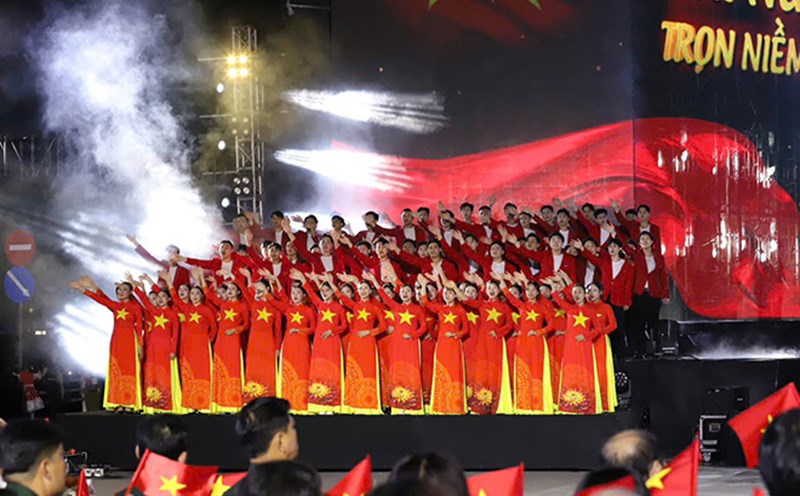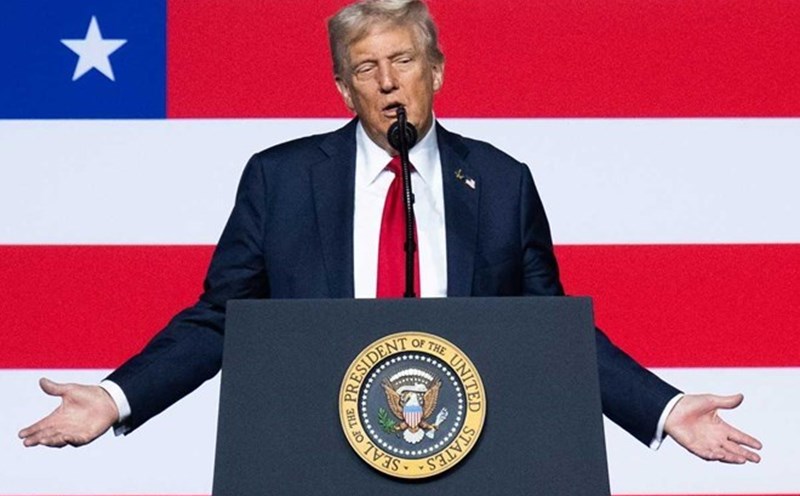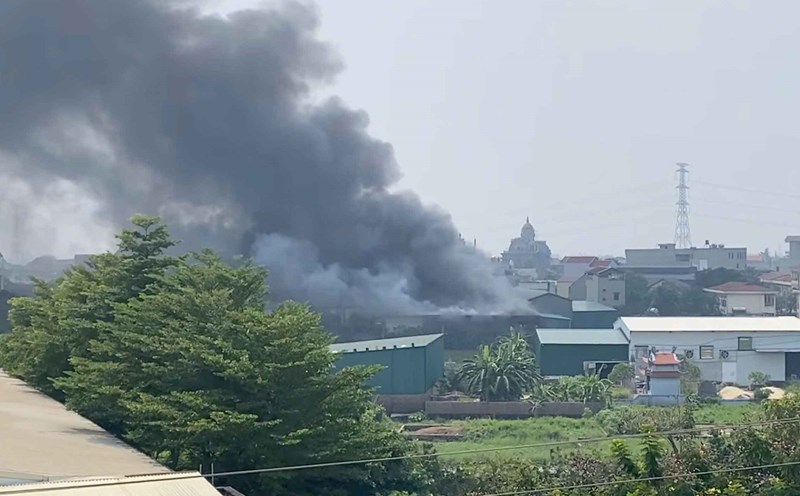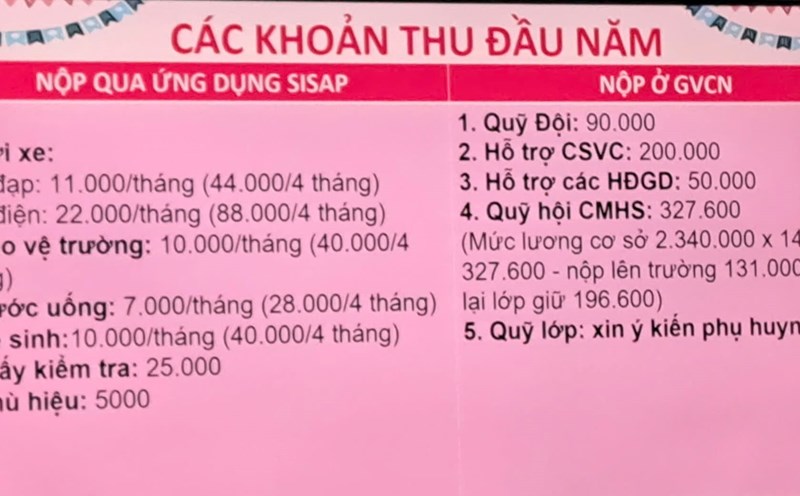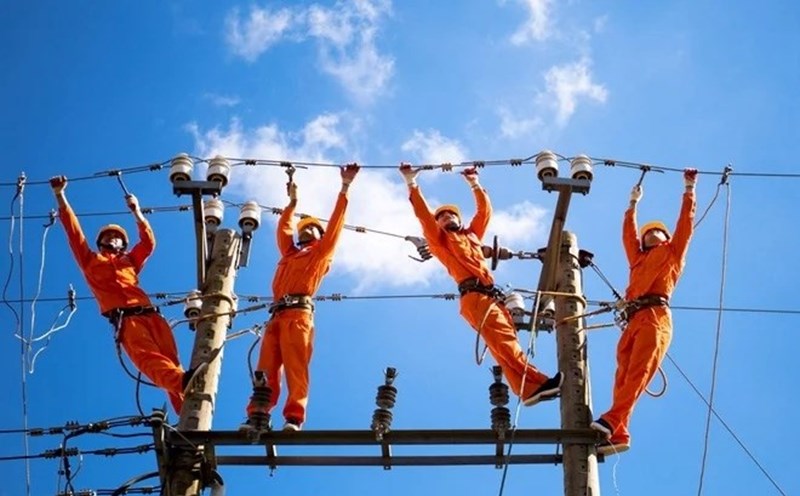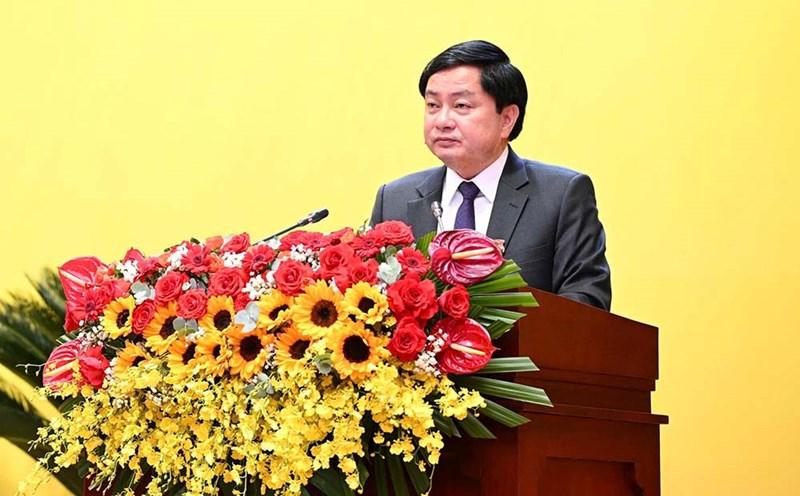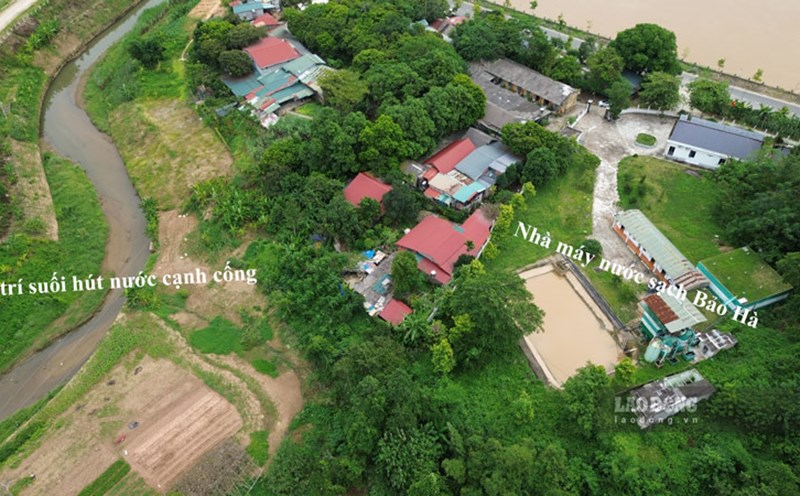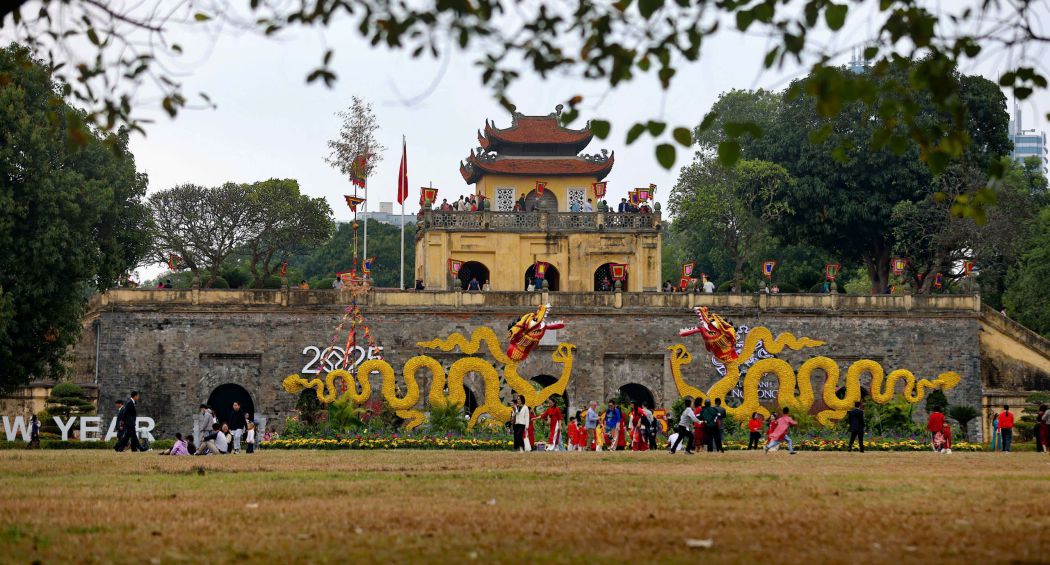
I don't know how many times I have passed by Phan Dinh Phung Street covered with a row of ancient crocodile trees and then looked at the gap on the northern gate of Thang Long Imperial Citadel and wondered: "What does that gap prove?".
In the novel "The bulletproof of Cua Bac", author Ngo Van Phu described: "Director Le Van Trinh built Cua Bac. A bullet hit the citadel gate in front of it, the sound of a dragon exploding made a landslide. Then the bullets exploded continuously in front. The water roared mud up almost to the surface of the citadel. Behind, the artillery shells fired several more shots. Quan Nam was hit by a bullet and died, causing many injuries. Some people were given a cut half the body... Our army is at a disadvantage! A cannon hit the citadel, injuring dozens more people. The citadel broke into a large patch. Thang people were thrown in the smoke, jostling forward, jostling back... However, after the smoke and bullets, the soldiers in brave brown shirts rushed up, slashing the French army who were climbing up the stairs to the capital (...) Si phu Bac Ha, could they ever sit still! ".
After taking the citadel, the French destroyed most of it, leaving only the main north gate because there were traces of bullets fired from the banks of the Red River. For Hanoians, the North Gate gate is a thousand-year-old testament to war crimes, and the will to not submit to the invasion of the Northern explorers.
After more than ten centuries, the Imperial Citadel of Thang Long is not only the political heart of the Dai Viet nation, but also a place of elite gathering, a place to affirm the bravery and intelligence of the Vietnamese people. Selected by King Ly Thai To as the capital in 1010, the land of "drawn-up" has become the center of power, the place to issue important decisions, the beginning of the period of brilliant development of Dai Viet civilization.
In August 2010, on the occasion of the 1,000th anniversary of Thang Long - Hanoi, UNESCO officially recognized the Central Area of Thang Long Imperial Citadel - Hanoi as a World Cultural Heritage, recognizing the unique historical and cultural values of this land. Not only meaningful to Vietnam, the Imperial Citadel of Thang Long is also recognized as a rare heritage in the world that demonstrates the long-lasting continuity of a national power center.
To be honored by UNESCO, Thang Long Imperial Citadel fully meets 3 cultural criteria. This place is a vivid testament to the intersection between Eastern and Western cultures, a place that receives the quintessence of Confucianism, Buddhism, Eastern feng shui teachings to the technical of the Western Vauban city. In that continuation, the Vietnamese people have created a unique urban model, both having the characteristics of the East and expressing the mindset of opening up and absorbing human knowledge.
The archaeological and cultural layers at the relic site of the 18th Dynasty and the central area of the Imperial Citadel show continuous traces throughout the 13th century. Rarely has there been a heritage in the world that has demonstrated so clearly the uninterrupted inheritance of a civilization.
Moreover, the Imperial Citadel of Thang Long is the center of power and a national symbol. From here, Vietnamese feudal dynasties sent congresses, received messengers, and discussed the country. Kinh Thien Palace - the heart of the Imperial Citadel - has been a symbol of the sovereign power of the Great Vietnamese National for 4 centuries.
After large-scale archaeological excavations since 2002, international scientists have not hesitated to praise him. Professor Yamanaka Akira (Japan) affirmed: Almost in Asia, there is no royal relic site that is preserved in the soil as good as in Thang Long Imperial Citadel. The French expert emphasized: "The world is lucky to have the Imperial Citadel of Thang Long".
Therefore, the Imperial Citadel of Thang Long is considered a typical ancient urban relic of the world, with value on par with ancient capitals such as: Truong An (China), Heijo-kyo (Japan) or Fono Romano (Italy).
Not only a tangible heritage, the Imperial Citadel of Thang Long is also an invaluable treasure of intangible culture. Each brick, each dragon's threshold, each stone phien tells the story of the ancestors' aspiration to build and protect the country. Preserving the Imperial Citadel is a way to visibly interpret the development process of the Vietnamese people for more than 1,000 years - from Dai Viet to modern Vietnam.
The Imperial Citadel of Thang Long is also a "lifestyle school" to help the younger generation understand history, the organization of the State apparatus, and the spirit of national autonomy. "Heritage education in schools" programs are regularly implemented to arouse pride and awareness of conservation in each citizen. The rich relic and relic layers help archaeologists, architects and historists have more valuable data to restore a complete picture of royal life, urban planning and ancient Vietnamese architectural thinking.
Not only is it the pride of the Vietnamese people, the Imperial Citadel of Thang Long is also a cultural message to friends around the world: Vietnam is a nation that knows how to preserve, create and integrate. A UNESCO representative in Vietnam once emphasized: There are few heritages in the world that show such a long-lasting continuity as the Imperial Citadel of Thang Long. This is a testament to the cultural stature of Vietnam in the flow of human civilization.
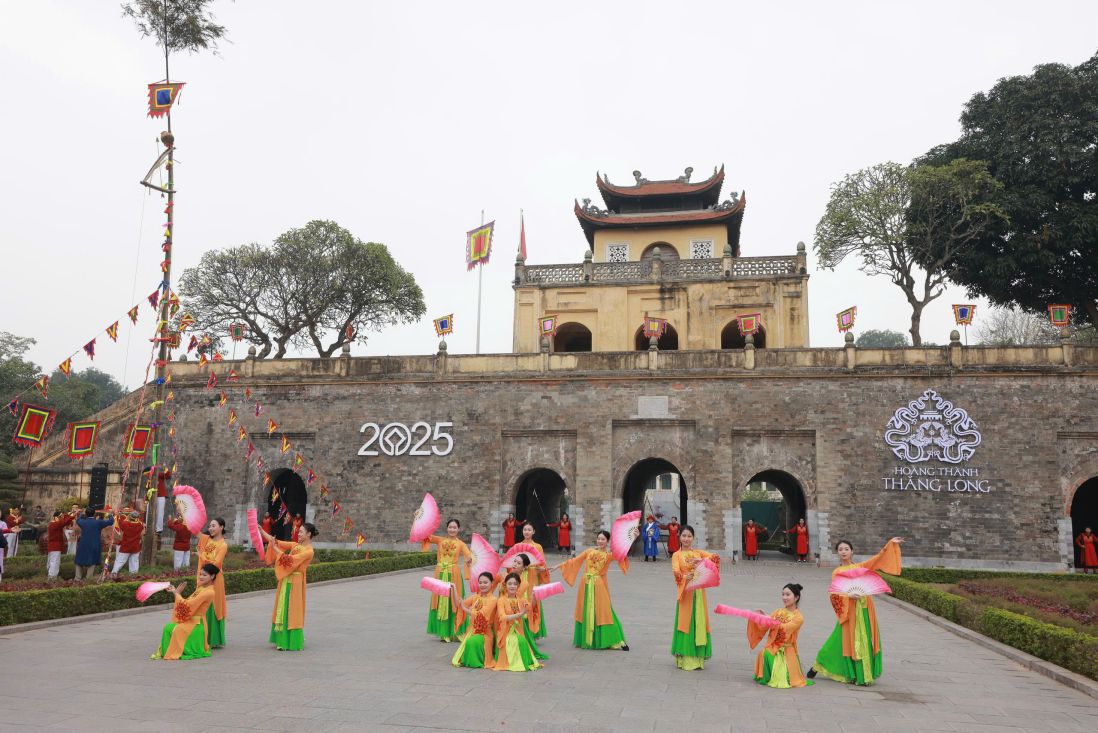
**
It is no coincidence that Hanoi chose the Imperial Citadel of Thang Long as the venue for the World Cultural Festival in Hanoi 2025. This is the mark of cultural exchanges of international stature, where the quintessence of the five continents converges in the space of Thang Long Imperial Citadel, lighting up the desire to connect and spread Vietnamese identity to the world.
When the sparkling lights shone on the ancient tiled roofs of the Imperial Citadel of Thang Long on the opening night of the World Cultural Festival in Hanoi, it was not only the light of the stage, but also the light of culture, the borderless language, where Vietnam confidently opened the door to the world with its own identity.
From October 10 to 12, 2025, the World Heritage space of Thang Long Imperial Citadel - the symbol of a thousand-year-old cultural Hanoi - will become a meeting place for 48 countries and territories.
For the first time, the cultural colors of the five continents gather in a space of Vietnamese heritage. More than 45 National Cultural Exhibition booths, 34 food stalls, 23 art troupes, 22 countries participating in film screenings and 12 publishing units... all blend together, creating a "multi-audience picture" of the world in the heart of the Capital.
The Imperial Citadel of Thang Long, expanded to Hanoi, is not only the political and administrative center of the country, but also a "heritage city", a place that preserves the profound cultural values of the Vietnamese people.
Hanoi has the Imperial Citadel of Thang Long - a symbol of the country's power and intelligence for more than 13 centuries; the Temple of Literature - Quoc Tu Giam - the first university in Vietnam, a place to honor talent; 36 streets - the soul of the ancient trading capital; One pillar Pagoda, Hoan Kiem Lake, Tay Ho Palace, Ngoc Son Temple - witnesses of the belief and spirituality of the Vietnamese people.
But what makes Hanoi especially is the ability to " live with heritage" - heritage that is not framed in a museum, but present in every breath of life.
From street vendors, early morning advertisements, to contemporary cultural spaces such as Hoan Kiem Lake walking street, Contemporary Art Center, Vietnam Exhibition Center in Dong Anh...
Most recently, the Hanoi Opera House and thematic Cultural and Arts Park project was started in Quang An peninsula, Tay Ho ward on October 5, celebrating the 71st anniversary of the Liberation of the Capital. This is a large-scale cultural and artistic project built with a total investment of nearly VND 12,800 billion from socialized capital. The project is not only a place to serve many different types of art performances such as symphony concests, Broadway music performances, Opera and classical Ballet, award events, Galas, large-scale entertainment performances, but also a large-scale space for cultural, artistic and entertainment exchanges for the people of the capital.
Coming to Hanoi, coming to the World Cultural Festival in Hanoi these days, people in the capital and tourists can step through the space of Japan with sophisticated tea ceremony art, to the corner of Russia that is quiet in the sound of balalaika, then stop by the Iranian booth with brilliant Persian carpets. Each country brings a part of its people's soul - simple but sincere.
The World Cultural Festival in Hanoi takes place in the heart of the Imperial Citadel of Thang Long - the origin of the Dai Viet nation - as a beautiful metaphor: Heritage is not only preserved but also renewed by creativity.
3D Mapping technology turns ancient walls into giant screens, recounting the journey of Vietnamese culture with light, sound and images. The fashion show "Heritage Steps" brought nearly 100 traditional costumes of ethnic groups from around the world to the stage, in harmony with Vietnamese music.
From the thousand-year-old bricks of Thang Long to today's technological light strips, Hanoi is sending a message: Preservation is not for storage, but for transmission and dissemination.
That is also the spirit that Hanoi is aiming for, to nurture the younger generation with culture, so that they not only inherit but also create new values.
Since Resolution 33-NQ/TW of the Central Committee on building and developing culture was implemented, culture has been affirmed as an endogenous strength, a great spiritual driving force of the nation. Hanoi - as the center - is pioneering the realization of that view.
The World Cultural Festival in Hanoi not only promotes the image of the country but also contributes to enhancing Vietnam's position in people's diplomacy, creating a foundation for Hanoi to become a "City for Peace" - a center for convergence and spreading global cultural values.
After the first World Cultural Festival in Hanoi, Hanoi hopes to open a series of annual cultural exchanges, attracting international tourists, creative experts and global artists.
Culture will not only be a spiritual foundation, but will become a resource for creative economic development - a new pillar in the sustainable development strategy of the Capital. When Hanoi opened its cultural door, the world also opened its heart to welcome Vietnam, a nation that respects other cultures and aspires to rise up through knowledge and art, a nation that loves peace.


